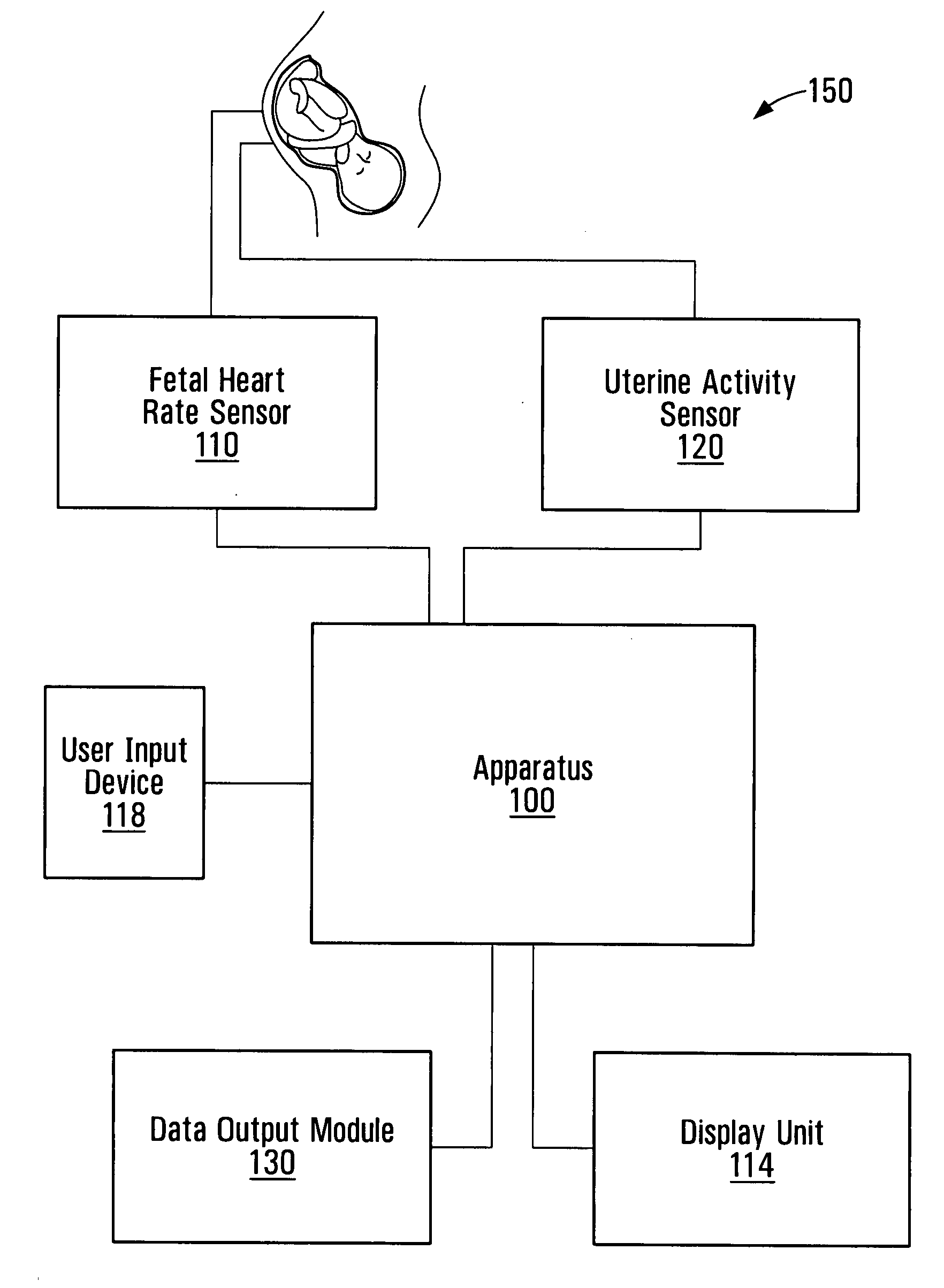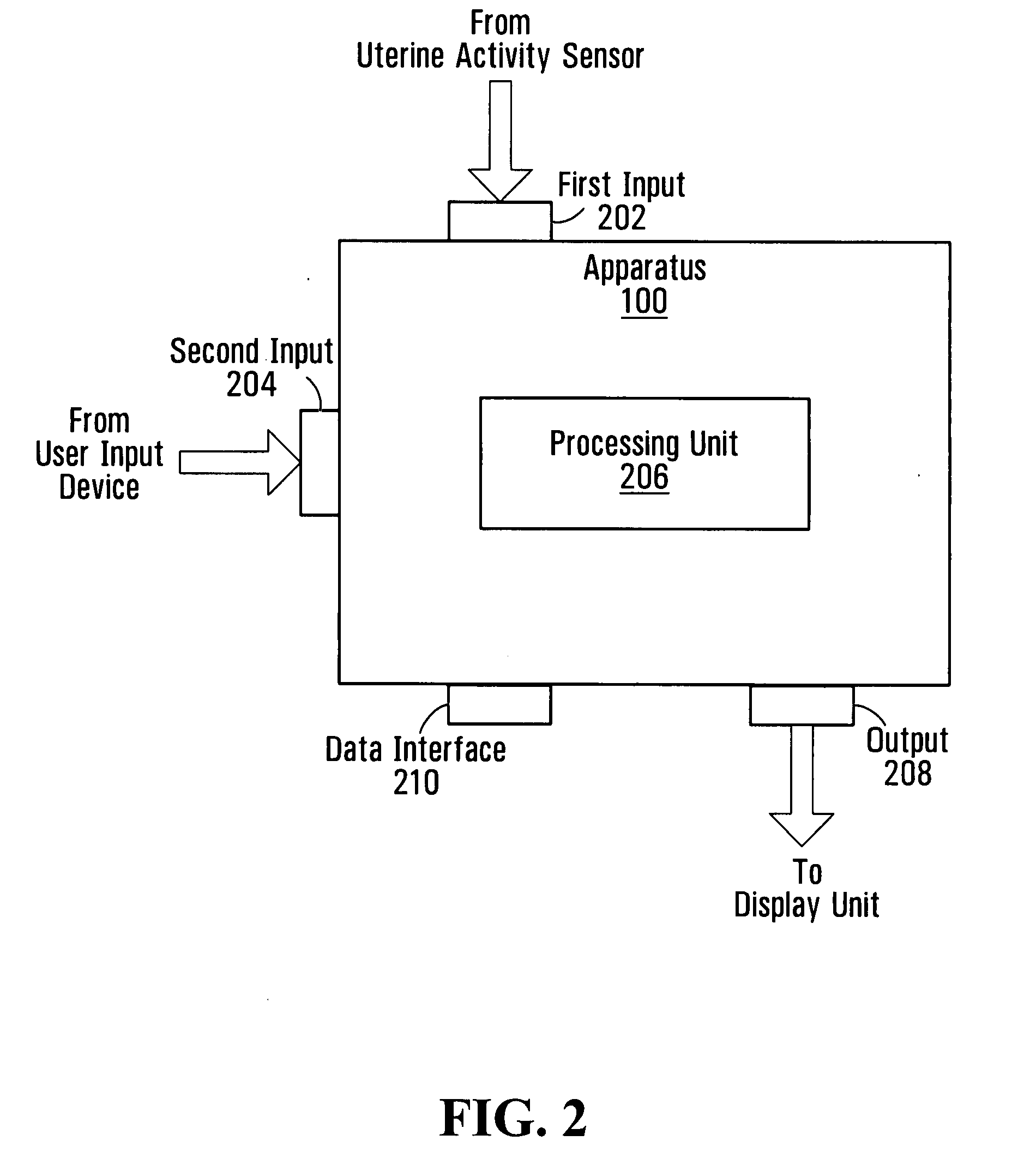[0008]An
advantage of the present invention is that it allows
clinical staff making use of the graphical
user interface module to readily track contraction rates and be provided with an indication, through the display of the threshold rate of uterine contractions, of a boundary defining safe care. As such, the
clinical staff is enabled to more easily assess labour progress. More specifically, the display of the graphical user interface module allows the
clinical staff to readily ascertain when the
contraction rate falls outside a limit set by the threshold rate of uterine contractions and, therefore, allows the clinical staff to take the necessary action in response to the occurrence of this event. In specific practical implementation, the threshold rate of uterine contractions will be set by hospital policy and / or on the basis of recognized best practices. The graphical user interface module also provides an
improved method for alerting the staff to conditions requiring intervention by causing an alarm event.
[0009]In accordance with specific examples of implementation, the graphical user interface module may cause an alarm event in response to a rate of uterine contractions conveyed by the first information falling outside a limit set by the threshold rate of uterine contractions. Alternatively, the graphical user interface module may cause an alarm event in response to a rate of uterine contractions conveyed by the first information exceeding the threshold rate of uterine contractions. Alternatively, the graphical user interface module may cause an alarm event in response to a rate of uterine contractions conveyed by the first information falling outside a limit set by the threshold rate of uterine contractions for a
time duration exceeding a predetermined
time duration. Advantageously, this second alternative allows the graphical user interface module to take into account a prolonged duration of an anomalous
contraction rate when causing an alarm event.
[0010]In accordance with specific examples of implementation, the graphical user interface module receives contraction
medication information conveying information associated to administration of contraction inducing medication to the
obstetrics patient. The contraction
medication information may indicate whether contraction-inducing medication was administered and, optionally, a dosage of the contraction inducing
medication administered. The graphical user interface module selectively causes an alarm
event based at least in part on a rate of uterine contractions conveyed by the first information, on the threshold rate of uterine contractions and on the contraction
medication information.
[0011]Advantageously, this alternative implementation allows the graphical user interface module to take into account whether contraction inducing medication was administered to the
obstetrics patient being monitored (and optionally the amount of contraction inducing medication which was administered) when causing an alarm event.
[0012]In accordance with another specific examples of implementation, the graphical user interface module receives
fetal heart rate information. The graphical user interface module selectively causes an alarm
event based at least in part on a rate of uterine contractions conveyed by the first information, on the threshold rate of uterine contractions and on the
fetal heart rate information. The
fetal heart rate information may including a
fetal heart rate signal or, alternatively, may include information conveying a level of risk associated with the
fetus, the level of risk being derived on the basis of a
fetal heart rate signal. Where the
fetal heart rate information includes a fetal
heart rate signal, the graphical user interface module is adapted for
processing the signal to determine a level of risk associated with the fetal
heart rate signal. Any suitable method for assessing a level of risk on the basis of a fetal
heart rate signal may be used. For example, the level of risk may be based on the frequency of the fetal heart rate, whether it is too high or too low for a certain period of time. Alternatively, the level of risk may be based on other suitable known methods. A non-limiting example of a method for providing an indication of the level of risk is described in U.S. Pat. No. 7,113,819, entitled “Method and apparatus for monitoring the condition of a
fetus”, issued on Sep. 26, 2006 to E. Hamilton et al. and assigned to LMS
Medical Systems Ltd. The contents of this document are incorporated herein by reference. Other suitable methods for assessing a level of risk on the basis of a fetal heart rate signal may be used without detracting from the spirit of the invention.
[0013]Advantageously, the above-described alternative implementation allows the graphical user interface module to take into account the behaviour of the fetal heart rate, and therefore the response of the baby, in combination with the
contraction rate when causing an alarm event.
 Login to View More
Login to View More  Login to View More
Login to View More 


